Developing Effective Home Interventions for Children with ADHD
VerifiedAdded on 2023/06/06
|6
|1524
|340
Report
AI Summary
This report provides an overview of Attention Deficit Hyperactivity Disorder (ADHD) in children and focuses on behavioral interventions that parents can implement at home. It emphasizes the importance of behavioral therapy alongside or instead of medication for some children. The report details several strategies for parents, including establishing clear and simple home rules, ignoring less severe inappropriate behaviors while praising appropriate ones, using clear and direct commands, and maintaining daily charts to track the child's progress. It also highlights the significance of establishing contingencies ahead of time, utilizing point or token systems for rewards, and considering a level system for more complex behavioral management. The creation of a dedicated homework hour is suggested to provide structure and parental support. The report underscores the need for parental training and collaborative efforts between parents and children to manage ADHD effectively, promoting desirable behaviors and discouraging problematic ones. This resource aims to equip parents with practical tools and knowledge to create a supportive home environment that fosters positive outcomes for children with ADHD.
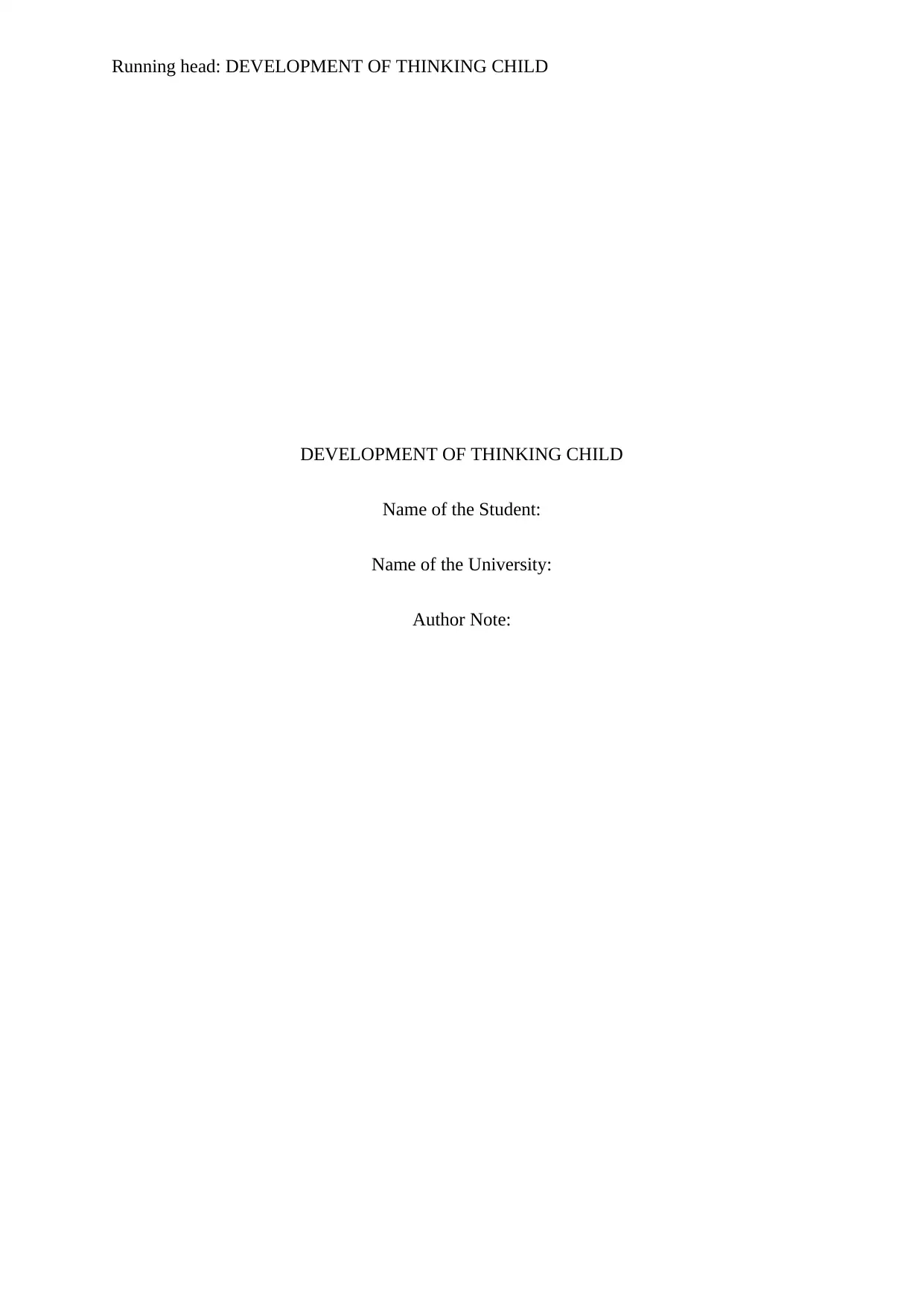
Running head: DEVELOPMENT OF THINKING CHILD
DEVELOPMENT OF THINKING CHILD
Name of the Student:
Name of the University:
Author Note:
DEVELOPMENT OF THINKING CHILD
Name of the Student:
Name of the University:
Author Note:
Paraphrase This Document
Need a fresh take? Get an instant paraphrase of this document with our AI Paraphraser
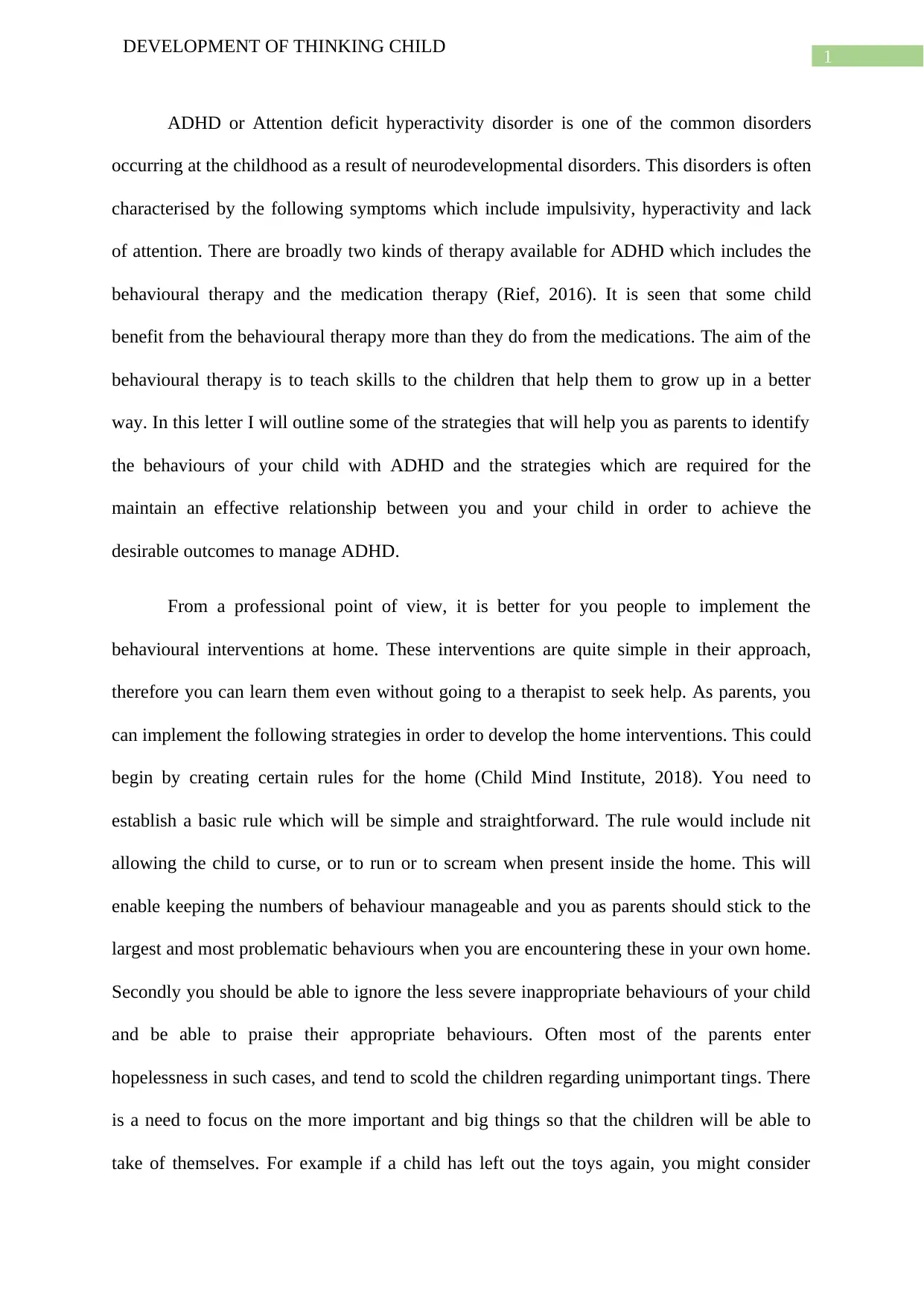
1
DEVELOPMENT OF THINKING CHILD
ADHD or Attention deficit hyperactivity disorder is one of the common disorders
occurring at the childhood as a result of neurodevelopmental disorders. This disorders is often
characterised by the following symptoms which include impulsivity, hyperactivity and lack
of attention. There are broadly two kinds of therapy available for ADHD which includes the
behavioural therapy and the medication therapy (Rief, 2016). It is seen that some child
benefit from the behavioural therapy more than they do from the medications. The aim of the
behavioural therapy is to teach skills to the children that help them to grow up in a better
way. In this letter I will outline some of the strategies that will help you as parents to identify
the behaviours of your child with ADHD and the strategies which are required for the
maintain an effective relationship between you and your child in order to achieve the
desirable outcomes to manage ADHD.
From a professional point of view, it is better for you people to implement the
behavioural interventions at home. These interventions are quite simple in their approach,
therefore you can learn them even without going to a therapist to seek help. As parents, you
can implement the following strategies in order to develop the home interventions. This could
begin by creating certain rules for the home (Child Mind Institute, 2018). You need to
establish a basic rule which will be simple and straightforward. The rule would include nit
allowing the child to curse, or to run or to scream when present inside the home. This will
enable keeping the numbers of behaviour manageable and you as parents should stick to the
largest and most problematic behaviours when you are encountering these in your own home.
Secondly you should be able to ignore the less severe inappropriate behaviours of your child
and be able to praise their appropriate behaviours. Often most of the parents enter
hopelessness in such cases, and tend to scold the children regarding unimportant tings. There
is a need to focus on the more important and big things so that the children will be able to
take of themselves. For example if a child has left out the toys again, you might consider
DEVELOPMENT OF THINKING CHILD
ADHD or Attention deficit hyperactivity disorder is one of the common disorders
occurring at the childhood as a result of neurodevelopmental disorders. This disorders is often
characterised by the following symptoms which include impulsivity, hyperactivity and lack
of attention. There are broadly two kinds of therapy available for ADHD which includes the
behavioural therapy and the medication therapy (Rief, 2016). It is seen that some child
benefit from the behavioural therapy more than they do from the medications. The aim of the
behavioural therapy is to teach skills to the children that help them to grow up in a better
way. In this letter I will outline some of the strategies that will help you as parents to identify
the behaviours of your child with ADHD and the strategies which are required for the
maintain an effective relationship between you and your child in order to achieve the
desirable outcomes to manage ADHD.
From a professional point of view, it is better for you people to implement the
behavioural interventions at home. These interventions are quite simple in their approach,
therefore you can learn them even without going to a therapist to seek help. As parents, you
can implement the following strategies in order to develop the home interventions. This could
begin by creating certain rules for the home (Child Mind Institute, 2018). You need to
establish a basic rule which will be simple and straightforward. The rule would include nit
allowing the child to curse, or to run or to scream when present inside the home. This will
enable keeping the numbers of behaviour manageable and you as parents should stick to the
largest and most problematic behaviours when you are encountering these in your own home.
Secondly you should be able to ignore the less severe inappropriate behaviours of your child
and be able to praise their appropriate behaviours. Often most of the parents enter
hopelessness in such cases, and tend to scold the children regarding unimportant tings. There
is a need to focus on the more important and big things so that the children will be able to
take of themselves. For example if a child has left out the toys again, you might consider
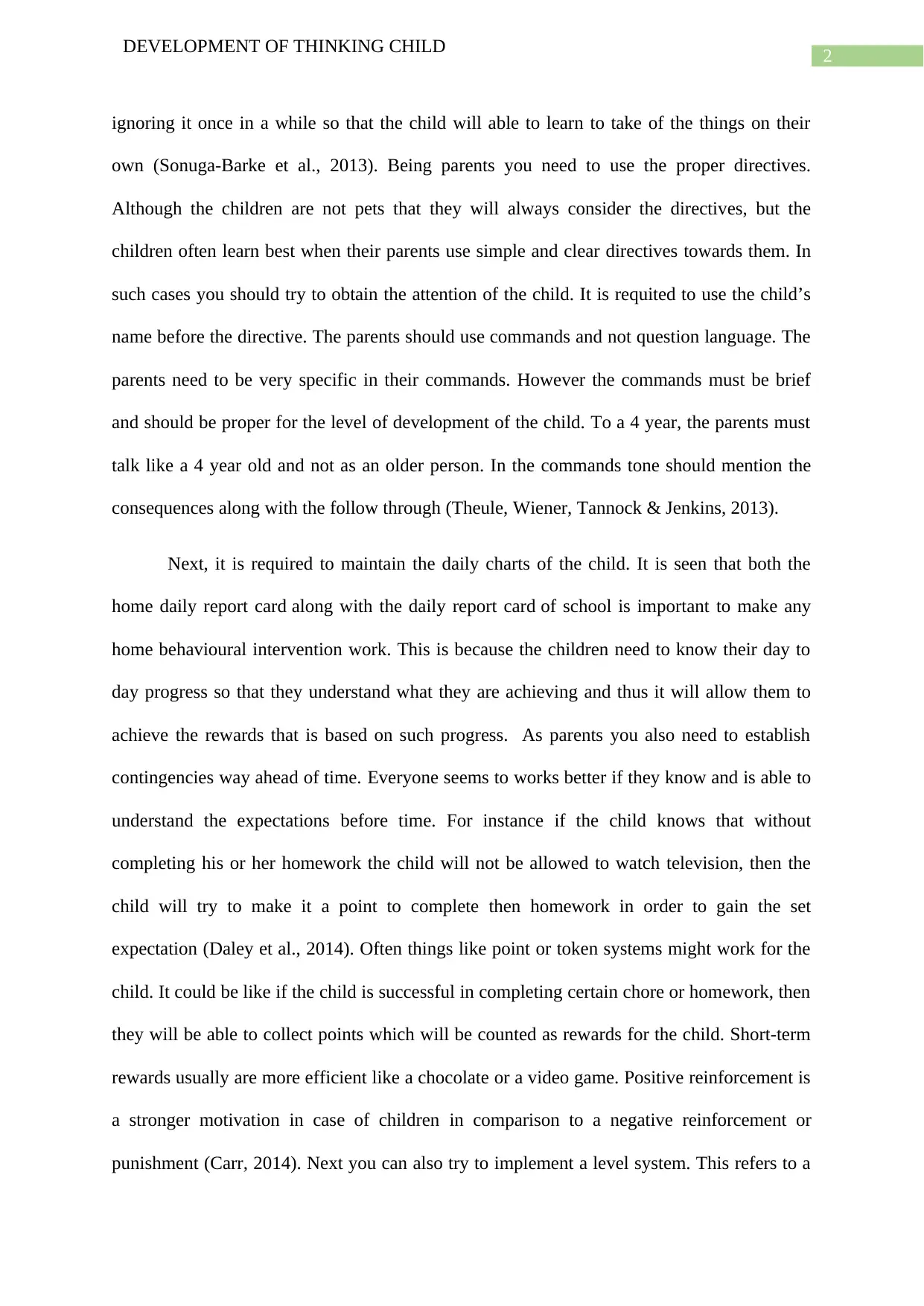
2
DEVELOPMENT OF THINKING CHILD
ignoring it once in a while so that the child will able to learn to take of the things on their
own (Sonuga-Barke et al., 2013). Being parents you need to use the proper directives.
Although the children are not pets that they will always consider the directives, but the
children often learn best when their parents use simple and clear directives towards them. In
such cases you should try to obtain the attention of the child. It is requited to use the child’s
name before the directive. The parents should use commands and not question language. The
parents need to be very specific in their commands. However the commands must be brief
and should be proper for the level of development of the child. To a 4 year, the parents must
talk like a 4 year old and not as an older person. In the commands tone should mention the
consequences along with the follow through (Theule, Wiener, Tannock & Jenkins, 2013).
Next, it is required to maintain the daily charts of the child. It is seen that both the
home daily report card along with the daily report card of school is important to make any
home behavioural intervention work. This is because the children need to know their day to
day progress so that they understand what they are achieving and thus it will allow them to
achieve the rewards that is based on such progress. As parents you also need to establish
contingencies way ahead of time. Everyone seems to works better if they know and is able to
understand the expectations before time. For instance if the child knows that without
completing his or her homework the child will not be allowed to watch television, then the
child will try to make it a point to complete then homework in order to gain the set
expectation (Daley et al., 2014). Often things like point or token systems might work for the
child. It could be like if the child is successful in completing certain chore or homework, then
they will be able to collect points which will be counted as rewards for the child. Short-term
rewards usually are more efficient like a chocolate or a video game. Positive reinforcement is
a stronger motivation in case of children in comparison to a negative reinforcement or
punishment (Carr, 2014). Next you can also try to implement a level system. This refers to a
DEVELOPMENT OF THINKING CHILD
ignoring it once in a while so that the child will able to learn to take of the things on their
own (Sonuga-Barke et al., 2013). Being parents you need to use the proper directives.
Although the children are not pets that they will always consider the directives, but the
children often learn best when their parents use simple and clear directives towards them. In
such cases you should try to obtain the attention of the child. It is requited to use the child’s
name before the directive. The parents should use commands and not question language. The
parents need to be very specific in their commands. However the commands must be brief
and should be proper for the level of development of the child. To a 4 year, the parents must
talk like a 4 year old and not as an older person. In the commands tone should mention the
consequences along with the follow through (Theule, Wiener, Tannock & Jenkins, 2013).
Next, it is required to maintain the daily charts of the child. It is seen that both the
home daily report card along with the daily report card of school is important to make any
home behavioural intervention work. This is because the children need to know their day to
day progress so that they understand what they are achieving and thus it will allow them to
achieve the rewards that is based on such progress. As parents you also need to establish
contingencies way ahead of time. Everyone seems to works better if they know and is able to
understand the expectations before time. For instance if the child knows that without
completing his or her homework the child will not be allowed to watch television, then the
child will try to make it a point to complete then homework in order to gain the set
expectation (Daley et al., 2014). Often things like point or token systems might work for the
child. It could be like if the child is successful in completing certain chore or homework, then
they will be able to collect points which will be counted as rewards for the child. Short-term
rewards usually are more efficient like a chocolate or a video game. Positive reinforcement is
a stronger motivation in case of children in comparison to a negative reinforcement or
punishment (Carr, 2014). Next you can also try to implement a level system. This refers to a
⊘ This is a preview!⊘
Do you want full access?
Subscribe today to unlock all pages.

Trusted by 1+ million students worldwide
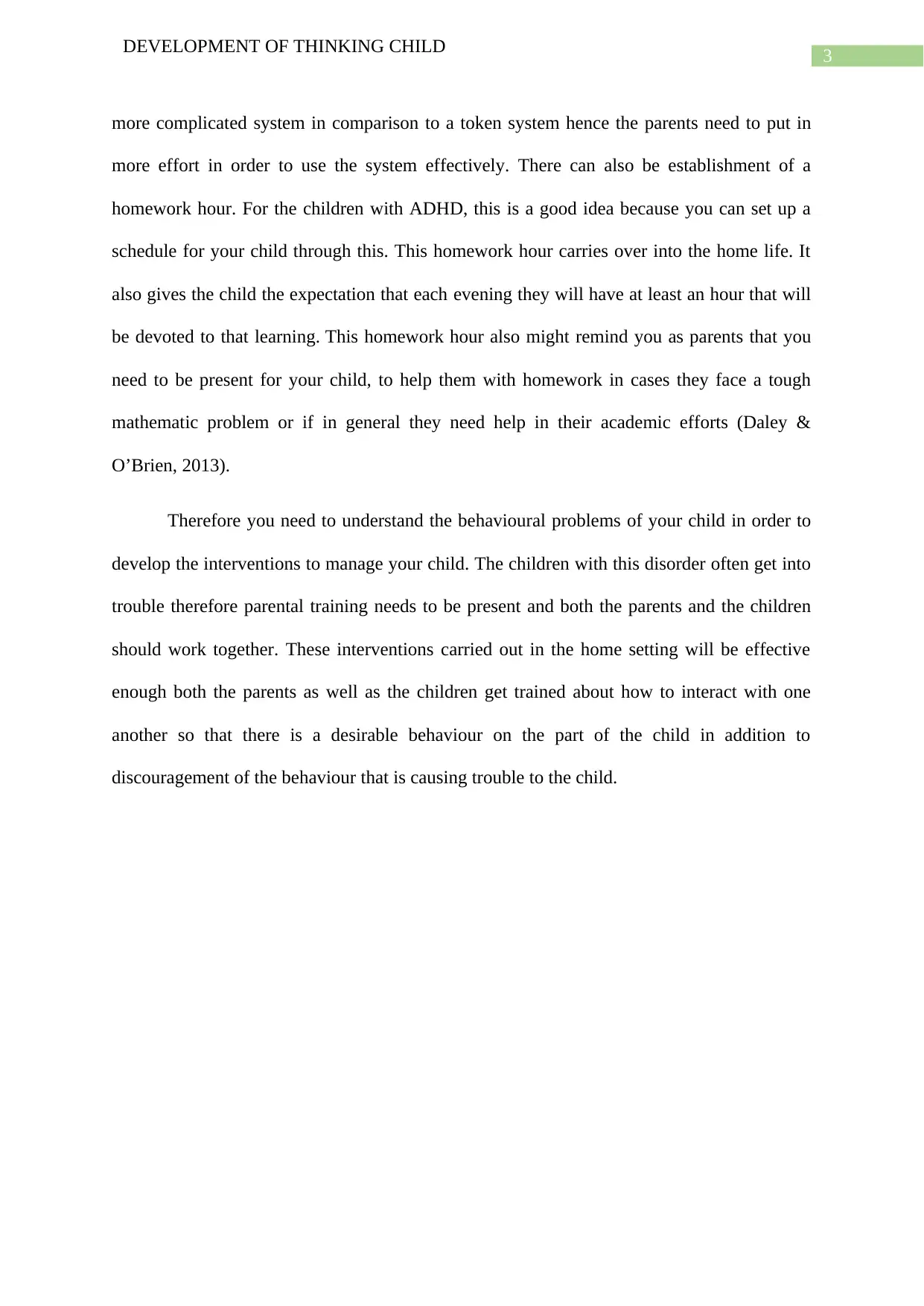
3
DEVELOPMENT OF THINKING CHILD
more complicated system in comparison to a token system hence the parents need to put in
more effort in order to use the system effectively. There can also be establishment of a
homework hour. For the children with ADHD, this is a good idea because you can set up a
schedule for your child through this. This homework hour carries over into the home life. It
also gives the child the expectation that each evening they will have at least an hour that will
be devoted to that learning. This homework hour also might remind you as parents that you
need to be present for your child, to help them with homework in cases they face a tough
mathematic problem or if in general they need help in their academic efforts (Daley &
O’Brien, 2013).
Therefore you need to understand the behavioural problems of your child in order to
develop the interventions to manage your child. The children with this disorder often get into
trouble therefore parental training needs to be present and both the parents and the children
should work together. These interventions carried out in the home setting will be effective
enough both the parents as well as the children get trained about how to interact with one
another so that there is a desirable behaviour on the part of the child in addition to
discouragement of the behaviour that is causing trouble to the child.
DEVELOPMENT OF THINKING CHILD
more complicated system in comparison to a token system hence the parents need to put in
more effort in order to use the system effectively. There can also be establishment of a
homework hour. For the children with ADHD, this is a good idea because you can set up a
schedule for your child through this. This homework hour carries over into the home life. It
also gives the child the expectation that each evening they will have at least an hour that will
be devoted to that learning. This homework hour also might remind you as parents that you
need to be present for your child, to help them with homework in cases they face a tough
mathematic problem or if in general they need help in their academic efforts (Daley &
O’Brien, 2013).
Therefore you need to understand the behavioural problems of your child in order to
develop the interventions to manage your child. The children with this disorder often get into
trouble therefore parental training needs to be present and both the parents and the children
should work together. These interventions carried out in the home setting will be effective
enough both the parents as well as the children get trained about how to interact with one
another so that there is a desirable behaviour on the part of the child in addition to
discouragement of the behaviour that is causing trouble to the child.
Paraphrase This Document
Need a fresh take? Get an instant paraphrase of this document with our AI Paraphraser
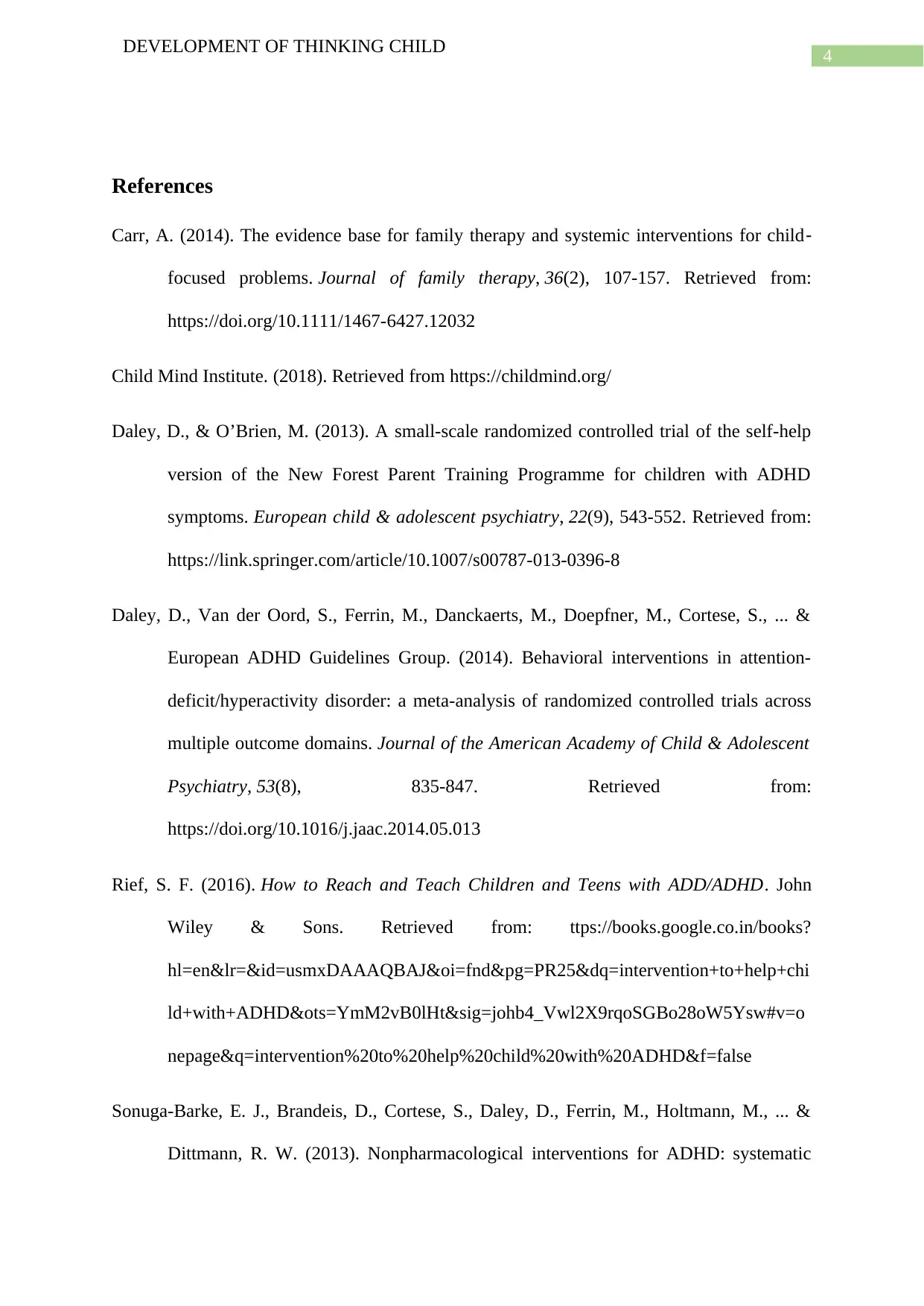
4
DEVELOPMENT OF THINKING CHILD
References
Carr, A. (2014). The evidence base for family therapy and systemic interventions for child‐
focused problems. Journal of family therapy, 36(2), 107-157. Retrieved from:
https://doi.org/10.1111/1467-6427.12032
Child Mind Institute. (2018). Retrieved from https://childmind.org/
Daley, D., & O’Brien, M. (2013). A small-scale randomized controlled trial of the self-help
version of the New Forest Parent Training Programme for children with ADHD
symptoms. European child & adolescent psychiatry, 22(9), 543-552. Retrieved from:
https://link.springer.com/article/10.1007/s00787-013-0396-8
Daley, D., Van der Oord, S., Ferrin, M., Danckaerts, M., Doepfner, M., Cortese, S., ... &
European ADHD Guidelines Group. (2014). Behavioral interventions in attention-
deficit/hyperactivity disorder: a meta-analysis of randomized controlled trials across
multiple outcome domains. Journal of the American Academy of Child & Adolescent
Psychiatry, 53(8), 835-847. Retrieved from:
https://doi.org/10.1016/j.jaac.2014.05.013
Rief, S. F. (2016). How to Reach and Teach Children and Teens with ADD/ADHD. John
Wiley & Sons. Retrieved from: ttps://books.google.co.in/books?
hl=en&lr=&id=usmxDAAAQBAJ&oi=fnd&pg=PR25&dq=intervention+to+help+chi
ld+with+ADHD&ots=YmM2vB0lHt&sig=johb4_Vwl2X9rqoSGBo28oW5Ysw#v=o
nepage&q=intervention%20to%20help%20child%20with%20ADHD&f=false
Sonuga-Barke, E. J., Brandeis, D., Cortese, S., Daley, D., Ferrin, M., Holtmann, M., ... &
Dittmann, R. W. (2013). Nonpharmacological interventions for ADHD: systematic
DEVELOPMENT OF THINKING CHILD
References
Carr, A. (2014). The evidence base for family therapy and systemic interventions for child‐
focused problems. Journal of family therapy, 36(2), 107-157. Retrieved from:
https://doi.org/10.1111/1467-6427.12032
Child Mind Institute. (2018). Retrieved from https://childmind.org/
Daley, D., & O’Brien, M. (2013). A small-scale randomized controlled trial of the self-help
version of the New Forest Parent Training Programme for children with ADHD
symptoms. European child & adolescent psychiatry, 22(9), 543-552. Retrieved from:
https://link.springer.com/article/10.1007/s00787-013-0396-8
Daley, D., Van der Oord, S., Ferrin, M., Danckaerts, M., Doepfner, M., Cortese, S., ... &
European ADHD Guidelines Group. (2014). Behavioral interventions in attention-
deficit/hyperactivity disorder: a meta-analysis of randomized controlled trials across
multiple outcome domains. Journal of the American Academy of Child & Adolescent
Psychiatry, 53(8), 835-847. Retrieved from:
https://doi.org/10.1016/j.jaac.2014.05.013
Rief, S. F. (2016). How to Reach and Teach Children and Teens with ADD/ADHD. John
Wiley & Sons. Retrieved from: ttps://books.google.co.in/books?
hl=en&lr=&id=usmxDAAAQBAJ&oi=fnd&pg=PR25&dq=intervention+to+help+chi
ld+with+ADHD&ots=YmM2vB0lHt&sig=johb4_Vwl2X9rqoSGBo28oW5Ysw#v=o
nepage&q=intervention%20to%20help%20child%20with%20ADHD&f=false
Sonuga-Barke, E. J., Brandeis, D., Cortese, S., Daley, D., Ferrin, M., Holtmann, M., ... &
Dittmann, R. W. (2013). Nonpharmacological interventions for ADHD: systematic
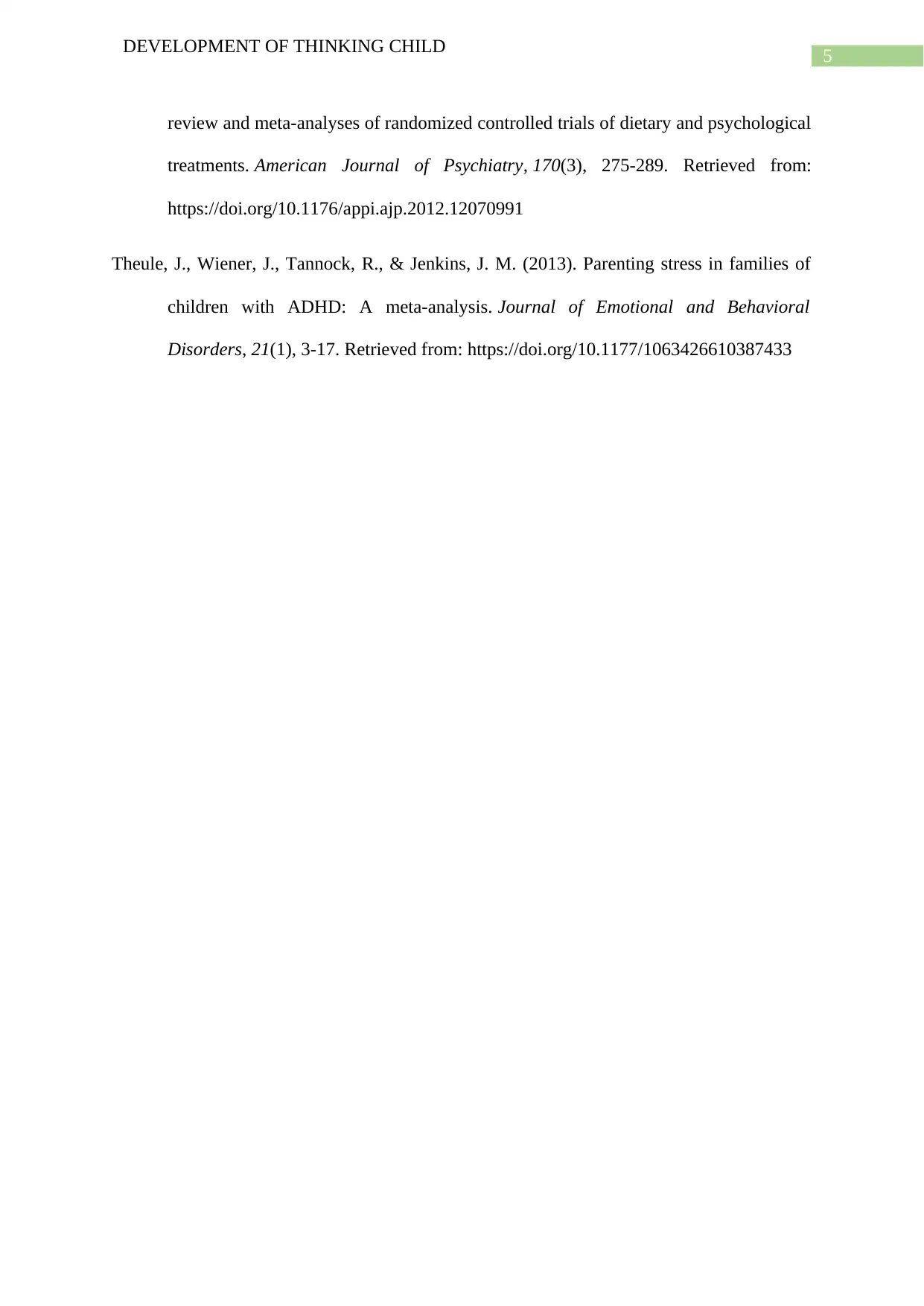
5
DEVELOPMENT OF THINKING CHILD
review and meta-analyses of randomized controlled trials of dietary and psychological
treatments. American Journal of Psychiatry, 170(3), 275-289. Retrieved from:
https://doi.org/10.1176/appi.ajp.2012.12070991
Theule, J., Wiener, J., Tannock, R., & Jenkins, J. M. (2013). Parenting stress in families of
children with ADHD: A meta-analysis. Journal of Emotional and Behavioral
Disorders, 21(1), 3-17. Retrieved from: https://doi.org/10.1177/1063426610387433
DEVELOPMENT OF THINKING CHILD
review and meta-analyses of randomized controlled trials of dietary and psychological
treatments. American Journal of Psychiatry, 170(3), 275-289. Retrieved from:
https://doi.org/10.1176/appi.ajp.2012.12070991
Theule, J., Wiener, J., Tannock, R., & Jenkins, J. M. (2013). Parenting stress in families of
children with ADHD: A meta-analysis. Journal of Emotional and Behavioral
Disorders, 21(1), 3-17. Retrieved from: https://doi.org/10.1177/1063426610387433
⊘ This is a preview!⊘
Do you want full access?
Subscribe today to unlock all pages.

Trusted by 1+ million students worldwide
1 out of 6
Related Documents
Your All-in-One AI-Powered Toolkit for Academic Success.
+13062052269
info@desklib.com
Available 24*7 on WhatsApp / Email
![[object Object]](/_next/static/media/star-bottom.7253800d.svg)
Unlock your academic potential
Copyright © 2020–2025 A2Z Services. All Rights Reserved. Developed and managed by ZUCOL.





